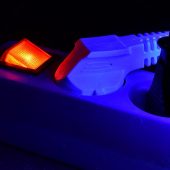A multimeter is one of the best tools for testing and diagnosing a plug socket.
You can use it to check whether the socket is live, how much voltage it is putting out, whether the wires are reversed and many other things.
Unless you are a professional electrician, a multimeter can be a confusing instrument to use with all the buttons, numbers and symbols.
Here’s a quick guide on how to safely test a plug socket with a digital multimeter.
Read on to learn more on how to test a plug socket with a multimeter.
Setting Up the Multimeter
The first step is to get your multimeter ready to test the socket.
Connect the probes to the right holes on the multimeter. Your multimeter should have two probes, one red and one black.
The black one goes into the slot labelled as COM while the red probe goes into the slot labelled with the letter V and the symbol Ω, which stands for ohms. This slot may also have additional letters such as mA or Hz.
Turn on the multimeter, and if you are in a dark area, turn on the backlight if your multimeter has a backlit display.
Turn the dial of the multimeter to measure AC voltage. Look for the symbol V~. The squiggly line can be above or next to the V.
The V~ covers a section of the round scale. Within that section will be several numbers that represent voltage range.
Select the lowest number that’s higher than the voltage of your socket. In the UK, standard socket voltage is 230V. Set the multimeter dial to a number that’s higher than that.
Note that not all multimeters require you to set a range. Some don’t even have numbers on the scale. The multimeter will set the range automatically when you take measurements.
Once you select a range, you are ready to test the socket.
Testing
To test the socket you use the multimeter leads. Hold the two leads in one hand (to prevent shock) and insert them into various slots on the socket to check voltage.
To measure the voltage from the socket, insert one lead into the live terminal (right slot) and the other into the neutral terminal (left slot).
Then check the voltage reading on the multimeter. It should be 230V or thereabouts. It can be slightly higher or lower.
To check if the wires are reversed, insert one lead into the earth terminal (top slot) and the other into the right slot. You should get a reading close to 230V. If you don’t, test the left slot.
With one lead still in the earth terminal, insert the other into the left slot. The voltage should be close to zero (max, 2V). If it’s 230V, the wires have been crossed.
Advanced Tests
If you do frequent socket tests to check if they are safe, a multimeter is not enough. We recommend buying a socket tester.
A socket tester can test for many other things including RCD, mains polarity and potentially dangerous wire reversals (live-neutral or live-earth reversals).



Before reading this, i just got a pretty loud “BANG” putting the both pins in the socket. So got a little scare there, no shock though. With cheap testers very important to set the meter to the right settings i guess. Wire should be in the little (that also called a socket ?) V on the meter, sins it has an Ohm sign also, i figured then maybe it should be in the one above it, called 10adc. So wouldn’t recommend doing that. Think i will give this a try, not right away, if you know what i mean.